Table of contents
- Unbiased Ascent Native Fuel Whey Review
- 🔑 Ascent Native Fuel Whey Review TL;DR
- 🛡️ How I Approach This Ascent Protein Review
- 📖 Ascent Native Fuel Whey Review Details
- 💪 Native Whey vs Regular Whey
- 🏋️♂️ When To Drink Ascent Protein?
- 🔑 Where To Buy Ascent Protein Powder TL;DR
- 🔑 Is Ascent Whey Protein Isolate Amino Spiked? TL;DR
- 🔑 Ascent Protein Third Party Testing, TL;DR
- 🔑 Protein Powder Comparison, TL;DR
- 🥤 How To Mix Ascent Protein Powder
- 👌 Ascent Protein Taste Review: Is It Any Good?
- 🔑 Ascent Protein Ingredients, TL;DR
- 🔑 Ascent Protein Powder Nutrition Facts, TL;DR
- ❓ Ascent Protein Powder FAQ
- 🏁 Ascent Native Fuel Whey Review – Final Thoughts
- 🧐 Ascent Native Fuel Whey Review Round-Up
- 📑 Ascent Native Fuel Whey Review Sources
Unbiased Ascent Native Fuel Whey Review
Ascent Protein quietly changed its formula in mid-2024. So, this Ascent Native Fuel Whey review breaks down whether it’s still the “clean post-workout recovery” protein it claims to be—or if Ascent slipped in extra protein under the usual “natural flavoring” label.
Ascent Native Fuel Whey Protein Powder Review: Is It Still “Clean”?
Summary
Ascent Native Fuel Whey Protein Powder claims to be a clean, high-quality post-workout shake—but did the quiet 2024 formula change impact its reputation? With 25g of protein per scoop, this whey blend still delivers solid macros. However, soy is now hidden under “natural flavors,” raising transparency concerns. It mixes decently, but clumping can occur. Taste? Stevia dominates, making it hit-or-miss. While Ascent still markets itself as a premium protein, better options exist without hidden ingredients.
Pros
- No artificial ingredients
- 25g protein per serving, ideal for post-workout recovery
Cons
- Soy hidden in formula
- Slightly overpriced for the transparency level
- Customer service is unresponsive
Ascent Native Whey Review: press play for the full analysis.
🔑 Ascent Native Fuel Whey Review TL;DR
If you don’t want to read my full Ascent Protein Powder Review, here’s your quick protein cheat sheet.
Not 100% Dairy-Based—Ascent’s latest formula quietly added soy, hiding it under “natural flavors.” This change raises concerns about amino acid inflation, as soy naturally contains leucine, potentially artificially boosting BCAA content.
Transparency Issues – While Ascent promotes its whey as high-quality, it does not disclose full protein ratios, filtration methods, or the specific sourcing of its dairy beyond vague claims of “trusted farmers.” The latest reformulation also saw a drop in BCAAs from 5.7g to 5.4g per serving.
Customer service is Nonexistent. I contacted Ascent multiple times about ingredient transparency and sourcing, but weeks later, I haven’t received a response. If you expect brand accountability, this isn’t the company for you.
Final Grade: 38/50 – 76% Above Average
While Ascent Native Fuel Whey still offers a clean ingredient list with no artificial additives, the hidden soy, transparency concerns, and lack of customer support make it a hard sell at this price. Better options exist.
🛡️ How I Approach This Ascent Protein Review
🌟 As a certified strength and conditioning expert (NSCA) and nutrition specialist (CISSN), I’m here to provide a no-nonsense Ascent Protein Review that cuts through the marketing hype. Each review is based on hands-on experience to determine if the product delivers on its claims.
👥 This Ascent Protein Review is driven by my interest or reader requests—never sponsorships or brand influence. I’ll call it out if a protein powder doesn’t meet the mark.
🔍 Transparenc key. While affiliate links may be included, my Ascent Protein Review will call it out if it remains 100% independent. Your health comes first.
📖 I break down every detail in my Ascent Protein Review, covering ingredients, sourcing, mixability, taste, and overall transparency—so you know exactly what you’re getting.
💼 My goal? To make this Ascent Protein Review clear, practical, and honest. After reading, you’ll have everything you need to decide if it’s worth your money.
📖 Ascent Native Fuel Whey Review Details
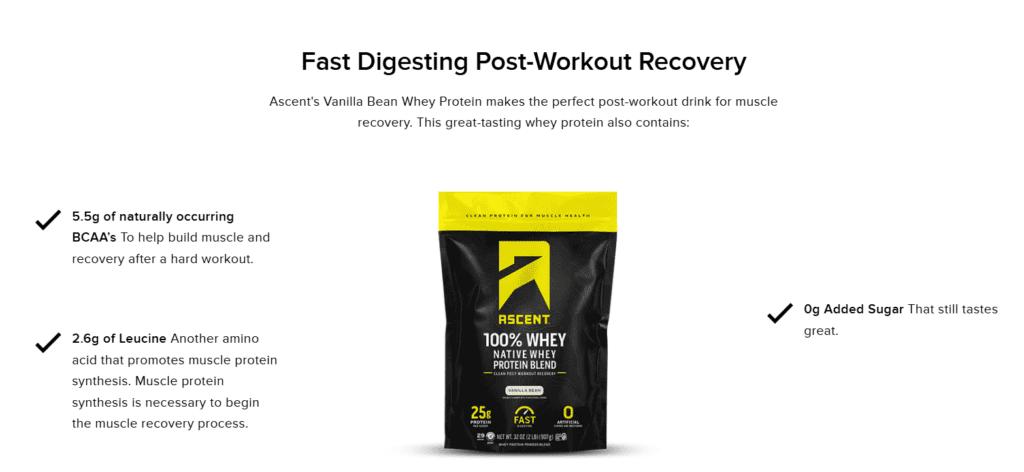
Ascent Native Fuel Whey has always marketed itself as a clean, high-quality protein powder. But with the latest 2024 reformulation, a few things have changed—and not for the better.
The most notable shift is the quiet addition of soy, which is now listed under allergens but hidden in “natural flavors.” Ascent is no longer 100% dairy-based protein, and the amino acid profile may be artificially inflated. The BCAA count has also dropped to 5.4g per serving, raising questions about whether soy protein is subtly padding the numbers.
Transparency is another issue. Ascent provides a full amino acid profile, but they don’t disclose the exact ratios of native whey, isolate, concentrate, and soy in the blend. Combine that with poor customer service—I’m still waiting for a response—and it’s clear Ascent isn’t as upfront as they claim.
At a glance, Ascent still looks like a decent protein powder. But if you’re paying for “clean and transparent,” this formula change makes that harder to believe.
💪 Native Whey vs Regular Whey
When comparing Native Whey vs Regular Whey, the biggest claim is that native whey has a higher leucine content due to its low-temperature microfiltration process. But does that lead to better muscle growth? Here’s what the research says.
Muscle Protein Synthesis (MPS) – Not a Game Changer
A 2019 study by Hamarsland et al. found that native whey spikes blood leucine levels higher than regular whey, but this does not translate into significantly greater muscle protein synthesis post-workout. Native whey performed only slightly better than milk in stimulating muscle growth.
Long-Term Recovery & Adaptations – Some Benefits
A 2018 study by Garcia-Vicencio et al. showed that native whey helped sustain neuromuscular recovery and reduced fatigue better than standard whey over a 12-week training period. This suggests better recovery potential, but not necessarily superior muscle gains.
Strength & Bioavailability – A Slight Edge
Finally, a 2023 study by Kim et al. on rats showed native whey had higher bioavailability, greater protein retention, and increased muscle strength over commercial whey. The difference? Less heat denaturation preserves protein function better than traditional whey.
Ranking Native Whey for Muscle Growth
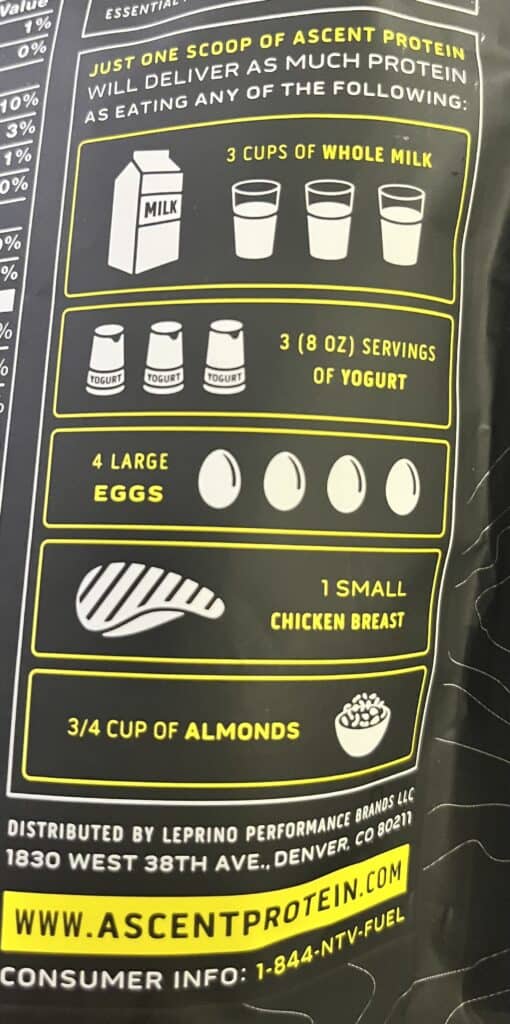
- Whey Isolate – Fastest absorption, highest protein percentage, best for post-workout recovery and muscle growth.
- Whey Concentrate – More calories, fats, and carbs make it ideal for muscle-building and weight gain.
- Native Whey – Higher bioavailability and slightly better recovery benefits than regular whey, but not a game-changer post-workout. Still, 25g of protein per serving is the baseline post-workout.
- Milk – Native whey marginally outperforms milk in stimulating muscle protein synthesis, but it’s not significantly ahead.
Bottom Line
If you’re strictly looking for the best protein post-workout, native whey isn’t going to outperform isolate or even a solid concentrate. However, its superior leucine content and potential for better recovery may make it a viable option for strength training over time.
🏋️♂️ When To Drink Ascent Protein?
Ascent Whey Protein Isolate is a fast-digesting protein, making it ideal post-workout when your muscles need quick amino acids for recovery. With 25g of protein per serving, it’s designed to kickstart muscle repair without unnecessary fillers.
If your goal is muscle growth or weight gain, you can take Ascent Whey Protein Isolate between meals to boost daily protein intake. For those focused on fat loss or lean muscle retention, it works well as a pre-workout option to prevent muscle breakdown during training.
The bottom line? Ascent Whey Protein Isolate is best for recovery after a workout, but its clean ingredient profile makes it flexible whenever you need a high-quality protein source.
💪 After Training Shake: How Many Scoops of Ascent Isolate Post Workout
One full scoop of Ascent Isolate delivers 25g of protein and 2.7g of leucine, hitting the research-backed threshold for post-workout muscle protein synthesis (MPS). If you’re looking for a simple, effective recovery shake, potentially one scoop of Ascent Protein Vanilla is all you need.
However, if you want to stretch your bag of Ascent Isolate without sacrificing results, consider using HP skim milk. According to USDA data, HP skim milk adds 13g of protein and 1.3g of leucine, meaning you can stimulate MPS with just three-forths of a scoop of Ascent Isolate while still hitting the minimum 25g protein and 2.5g+ leucine target.
The bottom line? One full scoop of Ascent Isolate could be enough, but pairing three-fourths of a scoop with HP skim milk is a smart way to extend your supply while stimulating MPS.
🔑 Where To Buy Ascent Protein Powder TL;DR
If you’re buying Ascent Protein Powder, you’ve got two main options: AscentProtein.com or Amazon. Which One’s Better?
Go with Ascent’s website for bulk savings, loyalty rewards, and better size options. Go with Ascent’s website for the best price on select sizes. If shipping, Amazon is the better choice—just keep an eye on price. Ascent Protein Powder
I purchased my Ascent Vanilla Bean directly from Amazon, but there are multiple places to buy Ascent Protein Powder—some offering better discounts than others. To keep things simple, I’m comparing two options: AscentProtein.com vs. Amazon. Let’s break down the perks of each.
| Buying from AscentProtein.com | Buying from Amazon |
| Full access to all flavors, supplements, and apparel One tree planted per order through Get Greens Park Free shipping on orders over $75 (continental U.S.) 10% Subscribe & Save discount + free shipping Wholesale discounts & loyalty points | Free 2-day shipping (Prime members) Same 5 flavors available 5% Subscribe & Save discount Amazon Downsides: price fluctuations by flavor and only two sizes are available; no 15-serving packets. |
| Pricing Breakdown $39.99 (15 single-serve packets), $2.67 per serving (S&S: $2.40) $44.99 (27 servings), $1.67 per serving (S&S: $1.50) $74.99 (54 servings), $1.39 per serving (S&S: $1.25) | Amazon Pricing for Vanilla Bean $39.94 (27 servings), $1.48 per serving (S&S: $1.40) $71.24 (54 servings), $1.32 per serving (S&S: $1.25) |
Which One’s Better?
For bulk savings and rewards, Ascent’s website is the best option. However, if you want Prime shipping and slightly better prices, Amazon is the better deal—just watch for price swings.
💸 Does Ascent Protein Have A Money-Back Guarantee?
Pulled directly from Ascent’s ‘Return Policy,’
“At Ascent, our goal is to make sure you are completely satisfied with your purchase and your experience with Ascentprotein.com. Please contact us within 30 days of delivery to return sealed product. For opened product, please contact us within 15 days of delivery. Products must be purchased directly from AscentProtein.com and limitations may apply. Please note, all items purchased at a discounted rate are final sales. Only non-discounted items can be refunded.”
The return policy page offers only a few details—no additional details beyond this statement. Visit the return policy page to initiate a return or address a product concern.
Want to contact customer service? Here’s what you need:
Phone: 1-844-622-9296 (straight to voicemail)
Email: customerservice@ascentprotein.com (include your order number)
Don’t expect a quick response. I’ve contacted Ascent protein three different times over the last four weeks, I still haven’t heard back.
Value: 4 out of 10.
At first glance, Ascent Whey Protein Isolate seems like a minimally processed, high-quality protein powder with zero artificial ingredients. But look closer; you’ll notice it’s not 100% milk-based.
🔑 Is Ascent Whey Protein Isolate Amino Spiked? TL;DR
No, Ascent Whey Protein Isolate isn’t amino spiked; the latest formula is a downgrade. Mid-2024, Ascent quietly reformulated their protein, reducing BCAAs from 5.7g to 5.4g per serving. The likely culprit? Soy is now listed under allergens but is hidden in “Natural Flavors.”
Previously, Ascent was 100% dairy-based. With soy mixed in, the formula isn’t as pure as before. While this isn’t traditional amino spiking, using soy to inflate BCAA content is a cost-cutting move, not a quality improvement.
This change matters if you’re after true dairy-only whey isolate. If I wanted soy, I’d buy plant protein.
The Final Verdict is that it is not amino-spiked, but it is not the same Ascent Whey Protein Isolate it used to be.
⚛️ Is Ascent Whey Protein Isolate Amino Spiked?
You won’t find a full amino acid profile listed when you grab a bag of Ascent Whey Protein Isolate. Instead, a small rectangle displays BCAAs, EAAs, and leucine per serving. While it departs from brands that provide full transparency, you can still find the complete amino acid profile here.
So, how does the new amino acid profile compare to the original? Read my original Ascent Native Whey Protein review, but here’s a side-by-side comparison:
Ascent Amino Acid Profile Comparison
| Ascent Amino Acid Profile Comparison | ||
| BCAA | Updated 2024 Ascent BCAA Profile | Original Ascent BCAA Profile |
| Leucine (g) | 2.6 | 2.7 |
| Isoleucine (g) | 1.5 | 1.6 |
| Valine (g) | 1.3 | 1.4 |
| Total BCAAs per Serving | 5.4 | 5.7 |
What’s Changed? The formula was altered mid-2024. My bag contains 5.7g of BCAAs, but newer versions dropped to 5.4g. The likely culprit? Soy.
Ascent Whey Protein Isolate was once 100% dairy. It’s blended with soy, likely hidden under “Natural Flavors.” If you check Amazon’s ingredient list, there’s no explicit mention, but the allergen warning now states “milk and soy.” Transparency Matters. If I wanted soy protein, I’d buy plant-based protein. Hiding soy behind “Natural Flavors” just to inflate BCAA content? No thanks.
Amino Spiking: 9 out of 10.
While Ascent Isolate isn’t amino-spiked, the soy inclusion is a cost-cutting downgrade. The latest formula is a step back.
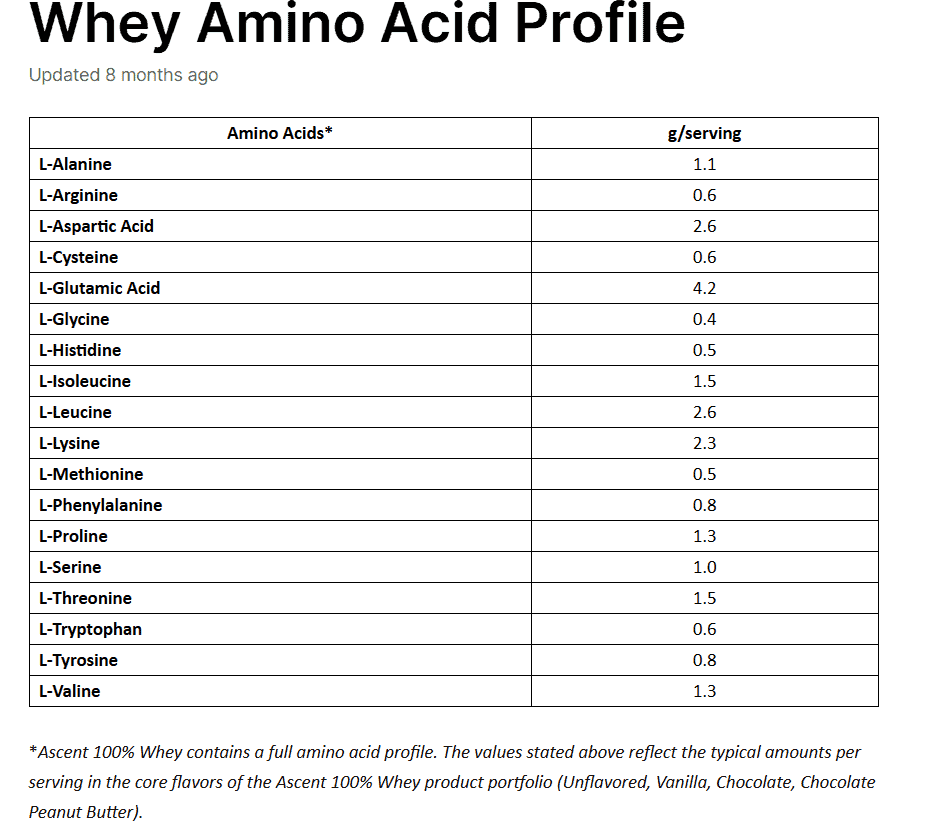

🔑 Ascent Protein Third Party Testing, TL;DR
Ascent Protein claims to be Informed Sport Certified, gluten-free, and sourced from “trusted” dairy farmers. But what’s verified? Only Informed Sport and gluten-free—everything else is unverified.
I contacted Ascent for a Certificate of Analysis (CoA) and country of origin list. My emails? Still sitting unread.
Could Ascent Protein be sourced from hormone- and antibiotic-free cows? Maybe. But they’re also using soy to boost the amino acid profile without listing it in the ingredients—raising transparency concerns.
And grass-fed? Not a chance. Comparing Ascent’s old and new BCAA profiles (5.7g vs. 5.4g) confirms it doesn’t meet true grass-fed standards.
Bottom line? It’s third-party tested for banned substances, but beyond that—don’t expect transparency.

📜 Ascent Protein Third Party Testing
Here’s what Ascent Isolate Protein Powder claims on the bag:
- Informed Sport Certified
- Gluten-Free
- rBST/rBGH Free
- Milk from “trusted” dairy farmers (USA not explicitly stated, just implied)
So, which claims are third-party verified? Only Gluten-Free and Informed Sport. Everything else is unverified. I contacted Ascent Protein for a Certificate of Analysis (CoA) and a list of countries of origin, but my emails are still unread.
Could this protein be sourced from hormone- and antibiotic-free dairy cows? Maybe. However, transparency is questionable because Ascent uses soy to boost the amino acid profile (without listing it in the ingredients).
Ascent also markets itself as a “clean” protein powder. If you’ve been following my reviews, you know I’ve seen this marketing tactic before—Axe & Sledge tried the same with Farm Fed Protein. So, is Ascent truly grass-fed? Let’s take a look.
🐄 Is Ascent Protein Grass Fed?
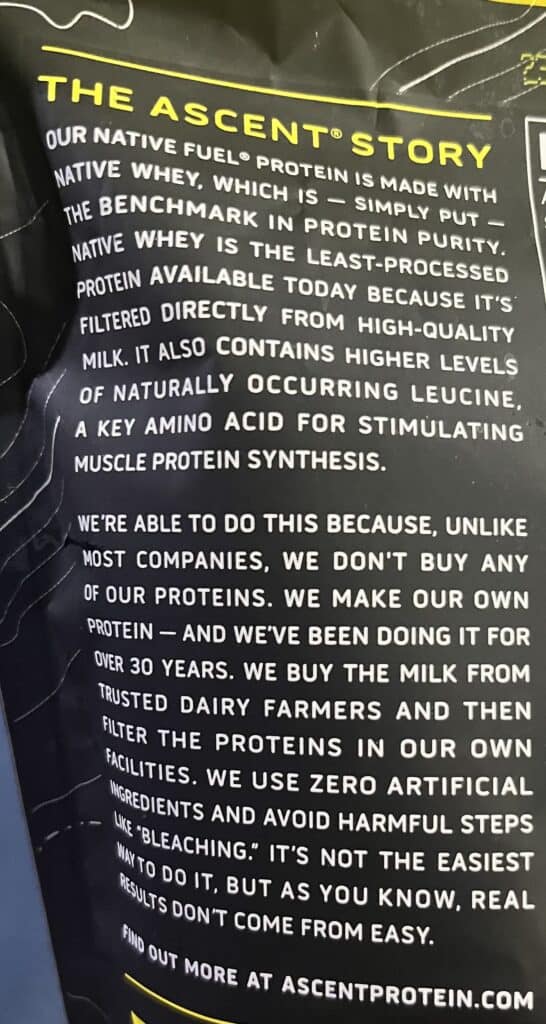
Some brands offer 100% grass-fed whey, like AGN Roots, while others use blended grass-fed whey, like Nutrabio Grass-Fed Whey. So where does Ascent land?
The bag claims “natural,” “high-quality milk,” and “rBST/rBGH-free.” But does that mean grass-fed?
A published AGN Roots article, “Grass-Fed Whey Contains More BCAAs,” explains that a whey protein’s BCAA profile can indicate whether dairy cows were grass-fed. Comparing Ascent’s old and new BCAA formula (5.7g vs. 5.4g), it’s clear—Ascent Whey is not grass-fed.
When we compare protein powders, Ascent’s BCAA profile is nearly identical to that of an industry leader.
🌿 Grass Fed Whey Protein Reviews
Looking for verified grass-fed whey protein? Not every brand claiming ” grass-fed ” meets strict sourcing and transparency standards. Some provide full third-party verification, while others rely on vague marketing. To help you sort through the noise, I’ve reviewed a wide range of grass-fed whey proteins—from certified Irish and New Zealand whey to USDA Organic options.
Not all grass-fed whey is created equal. If you want truly verified grass-fed whey, check out my Truly Grass Fed Protein section, where I cover certified Irish whey brands with full transparency. If you’re looking for New Zealand whey protein, I’ve compiled a full list. While many brands claim to source in New Zealand, not all back this up with third-party verification. USDA Organic Whey Protein is the only standard for certified USA-sourced whey. USDA Organic whey ensures no synthetic pesticides, herbicides, or antibiotics, making it the cleanest grass-fed option. Want a complete breakdown? My Grass-Fed Whey Protein Guide covers claimed and verified brands, analyzing transparency, certifications, and quality testing to help you make the best choice.
🔑 Protein Powder Comparison, TL;DR
ON Gold Standard Whey is the clear winner if you’re chasing muscle growth, value, and transparency. It delivers a verified 10.83% leucine content, a full amino acid profile, and no hidden soy under ‘natural flavors.’ Ascent Native Fuel Whey hides its exact protein blend and amino breakdown, raising red flags on soy content artificially boosting leucine levels.
Isopure? Amino spiked. No full amino acid profile, undisclosed leucine levels, and potentially inflated protein claims—not worth your money.
Orgain is good for meal replacement but not muscle building. It’s lower protein per serving, 8.4% leucine, and high carb count make it a different category altogether.
Final Call: Optimum Nutrition Gold Standard Whey is available for the best protein for muscle building and value.
📊 Protein Powder Comparison
When stacking Ascent Native Fuel Whey against its competition, three protein powders stand out:
- Optimum Nutrition Gold Standard Whey – The industry giant. ON Whey offers a trusted formula, slightly better leucine percentage (10.83%), and a lower per-serving price than Ascent. It’s a blended protein but the best in its category.
- Isopure Zero Carb – A keto-friendly whey isolate, but major transparency issues hold it back. No disclosed leucine content, a proprietary amino acid profile, and red flags for amino spiking make it a questionable choice.
- Orgain Sport Protein – A plant-based protein built for meal replacement, not post-workout recovery. Lower leucine (1.77g) and higher carbs (15g) make it better suited for satiety than muscle-building.
Ascent competes well in quality, ingredient transparency, and protein composition, but does it take the top spot? Let’s break it down.
🆚 Whey Protein Powder Comparison: Ascent Native Fuel Whey vs Optimum Nutrition
When comparing Ascent Native Fuel Whey vs Optimum Nutrition, both provide 25g of protein per serving, but differences in leucine content, carb count, and pricing set them apart.
Protein & Amino Acid Breakdown
Both proteins offer 5.5g of BCAAs per serving. However, ON Gold Standard Whey has a slightly higher leucine percentage (10.83% vs. 10.4%), delivering a marginally better protein composition for muscle growth.
Macronutrient Comparison
- Ascent Native Fuel Whey has fewer carbs (2g vs. 4g), making it a leaner option for those monitoring carbohydrate intake. It also contains <1g of fiber, which ON Whey lacks.
- Optimum Nutrition Gold Standard Whey has 1g more sugar per serving, but overall calorie content remains at 120 calories per scoop.
Price & Value
- Ascent Protein is priced at $1.37 per serving.
- ON Gold Standard Whey is slightly cheaper at $1.34 per serving, offering a better price point for the same number of servings.
Bottom Line
If lower carbs and added fiber are your priority, Ascent Native Fuel Whey is the better choice. But for slightly better protein offering no soy at a lower price, Optimum Nutrition Gold Standard Whey wins in value.
Best Deal? Check Amazon for ON Whey pricing here.
| Comparison Metrics | Ascent Protein Powder Vanilla Bean | ON Gold Standard Vanilla Ice Cream |
| Leucine (g) | 2.6 | 2.6 |
| Leucine Percent (%) | 10.4 | 10.83 |
| Total BCAAs (g) | 5.5 | 5.5 |
| Protein per Serving (g) | 25 | 24 |
| Carbs per Serving (g) | 2 | 4 |
| Fiber per Serving (g) | <1 | 0 |
| Total Sugars (g) | 1 | 1 |
| Calories | 120 | 120 |
| Serving Size (g) | 31 | 31 |
| Number of Servings | 29 | 29 |
| Amazon Price | $39.94 | $39.04 |
| Price per Serving | $1.37 | $1.34 |
🆚 Whey Protein Powder Comparison: Ascent Protein vs Isopure
When comparing Ascent Native Fuel Whey vs Isopure, the biggest red flag is Isopure’s lack of transparency. Ascent provides clear nutritional details, while Isopure keeps its leucine content and amino acid profile proprietary—a common tactic in amino-spiked protein powders.
Key Differences
- Leucine & Amino Profile: Ascent lists 2.6g of leucine per serving, while Isopure provides no specific leucine data—just a generic “5.5g BCAAs” claim.
- Carb & Sugar Content: Isopure is zero-carb, zero-sugar, making it keto-friendly, whereas Ascent has 2g of carbs and 1g of sugar per serving.
- Ingredient Transparency: Ascent discloses its full protein breakdown, while Isopure refuses to share its full amino acid profile, a red flag for amino spiking.
- Serving Size & Price: At $1.14 per serving, Isopure offers 66 servings per container, making it seem like a better value than Ascent’s $1.37 per serving for 29 servings. However, considering quality over quantity, Isopure’s questionable transparency makes that lower price less appealing.
The Bottom Line
If you want a proven-quality transparent protein powder, Ascent Native Fuel Whey is the better choice. Isopure’s undisclosed leucine content and refusal to provide a full amino acid profile raise major concerns about amino spiking. If keto-friendliness is your only priority, Isopure might fit the bill—but at the cost of transparency.
Read my Isopure Zero Carb Protein Review or grab a tub from Amazon for a full breakdown.
| Comparison Metrics | Ascent Protein Powder Vanilla Bean | Isopure Protein Natural Vanilla |
| Leucine (g) | 2.6 | Unknown |
| Leucine Percent (%) | 10.4 | Unkown |
| Total BCAAs (g) | 5.5 | 5.5 |
| Protein per Serving (g) | 25 | 25 |
| Carbs per Serving (g) | 2 | 0 |
| Fiber per Serving (g) | <1 | 0 |
| Total Sugars (g) | 1 | 0 |
| Calories | 120 | 100 |
| Serving Size (g) | 31 | 31 |
| Number of Servings | 29 | 66 |
| Amazon Price | $39.94 | $74.99 |
| Price per Serving | $1.37 | $1.14 |
🆚 Whey Protein Powder Comparison: Ascent Protein vs Orgain Protein Powder
When comparing Ascent Protein vs Orgain Protein Powder, the key differences are protein content, leucine percentage, and overall macronutrient composition. Ascent Native Fuel Whey is a whey protein isolate blend designed for post-workout recovery, while Orgain Protein Powder is a plant-based option focused on meal replacement and satiety.
Key Differences
- Protein & Leucine: Ascent delivers 25g of protein with 2.6g of leucine per serving—a crucial threshold for muscle protein synthesis. In contrast, Orgain provides 21g of protein with only 1.77g of leucine, making it less optimal for muscle-building.
- Carbs & Fiber: If you’re looking for a low-carb protein, Ascent dominates with just 2g of carbs, compared to Orgain’s 15g of total carbs and 4g of fiber—positioning Orgain as a better meal replacement option.
- Price Per Serving: Orgain is cheaper overall at $30.98, but Ascent offers more servings (29 vs. 20) and a lower price per gram of protein.
Bottom Line
If your goal is muscle recovery and high-quality protein, Ascent Protein Powder is the clear winner due to its higher leucine percentage and superior protein per serving. However, if you’re looking for a plant-based option with fiber for meal replacement, Orgain Protein Powder might be a better fit.
For a deeper dive into Orgain, read the full review here: Orgain Sport Protein Review
Grab Orgain Protein on Amazon: Buy Here
| Comparison Metrics | Ascent Protein Powder Vanilla Bean | Orgain Protein Powder Vanilla |
| Leucine (g) | 2.6 | 1.77 |
| Leucine Percent (%) | 10.4 | 8.4 |
| Total BCAAs (g) | 5.5 | 3.987 |
| Protein per Serving (g) | 25 | 21 |
| Carbs per Serving (g) | 2 | 15 |
| Fiber per Serving (g) | <1 | 4 |
| Total Sugars (g) | 1 | 1 |
| Calories | 120 | 150 |
| Serving Size (g) | 31 | 46 |
| Number of Servings | 29 | 20 |
| Amazon Price | $39.94 | $30.98 |
| Price per Serving | $1.37 | $1.55 |
⭐️ Amazon Whey Protein Review: Ascent Protein Powder Review
As of this Ascent Protein Powder review, it holds a 4.6 out of 5-star rating on Amazon. Here’s what satisfied buyers highlighted in their Ascent Protein Powder review:
- Clean ingredient profile with zero artificial additives
- Easy mixability and good taste for the price
- Minimal bloating or stomach discomfort
On the flip side, negative Ascent Protein Powder reviews mention:
- Terrible customer service—no phone support, emails ignored
- Overly sweet, medicinal taste due to stevia
- Difficult-to-seal bag and frustrating mixability
So, where do I stand on Ascent Protein Powder reviews?
The zero artificial ingredients claim holds up, and I experienced minimal bloating. However, I also encountered the same negatives other reviewers mentioned: inconsistent mixability, overly sweet, unresponsive customer service, and no follow-up on my review questions after four weeks.
A 4.6-star rating? That feels inflated.
Ascent Native Fuel Whey Protein Powder Review: Is It Still “Clean”?
Summary
Ascent Native Fuel Whey Protein Powder claims to be a clean, high-quality post-workout shake—but did the quiet 2024 formula change impact its reputation? With 25g of protein per scoop, this whey blend still delivers solid macros. However, soy is now hidden under “natural flavors,” raising transparency concerns. It mixes decently, but clumping can occur. Taste? Stevia dominates, making it hit-or-miss. While Ascent still markets itself as a premium protein, better options exist without hidden ingredients.
Pros
- No artificial ingredients
- 25g protein per serving, ideal for post-workout recovery
Cons
- Soy hidden in formula
- Slightly overpriced for the transparency level
- Customer service is unresponsive
🥤 How To Mix Ascent Protein Powder
When following the mixing instructions for Ascent Protein Whey, the brand explicitly states to add liquid to your container before mixing or shaking. Here’s what they recommend:
- Use at least 8 fluid ounces of your preferred beverage.
- For a thicker shake, stick to 4 to 8 ounces; use more than 8 ounces for a thinner shake.
- Shake well.
Despite following these instructions, I still ended up with Ascent Protein Whey clumping along the shaker wall—not just minor specks, but large, undissolved chunks. As we saw in my TAHA Whey Protein Concentrate Review, filtration plays a massive role in mixability. Panchal et al. (2021) found that filtration methods and emulsifiers directly affect how dairy proteins interact with water and fat. Cold-filtered whey typically has better emulsification properties, leading to smoother, more even mixing.
Given the mixability issues, it’s likely that one or more of the proteins in Ascent Protein Whey have gone through a high-heat filtration process. I’m not saying you’ll be chewing on chunks in your post-workout shake, but seeing undissolved Ascent Protein Whey clumped on the shaker wall isn’t exactly ideal.
⚖️ Ascent Protein Scoop Size
Ascent Protein Whey states that one rounded scoop equals a 31-gram serving. After weighing it, I confirmed that a flat scoop is less than serving. So, go big with the scoop.
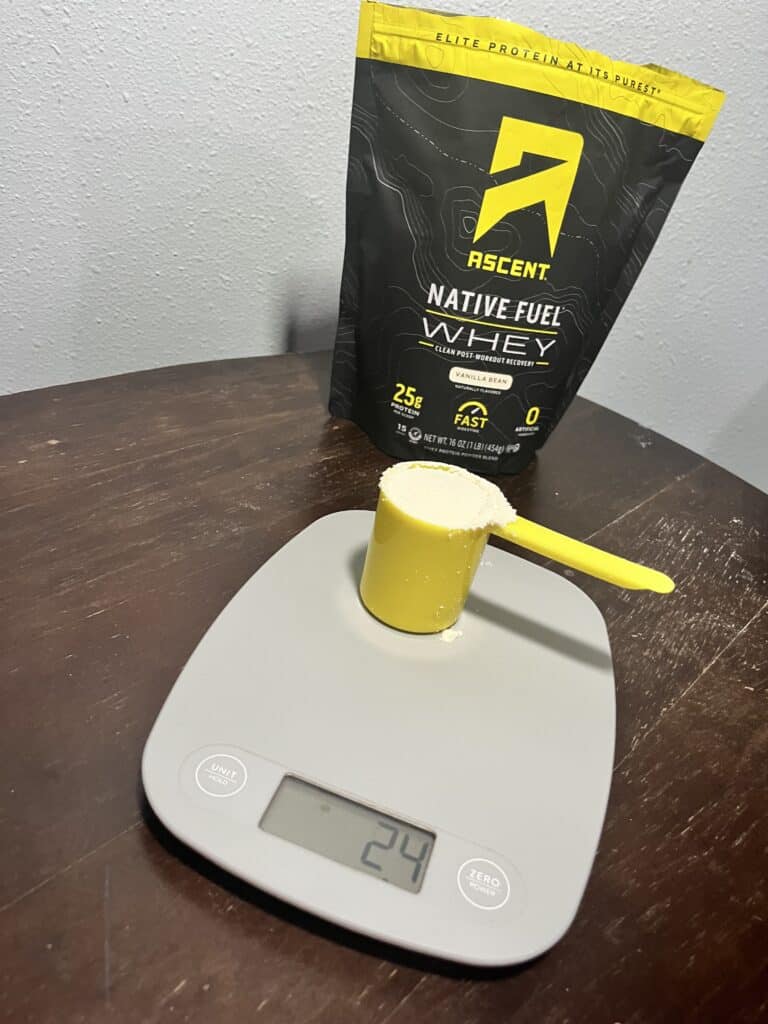
👌 Ascent Protein Taste Review: Is It Any Good?
If you’re searching for a natural sweetener protein powder, Ascent Native Fuel Whey might seem like a solid choice. But that can be a double-edged sword. My taste buds share that stevia tastes overly sweet and medicinal, making drinking less enjoyable. If you’re wondering which natural sweetener protein powders use stevia, I’ve compiled a full list of the ones I’ve reviewed.
So, what sweetener does Ascent Native Fuel Whey use? You guessed it—stevia. While the vanilla flavor starts strong, the stevia comes in like an uninvited guest, completely overpowering it. If I weren’t so sensitive to stevia (yeah, I know—call me a snowflake), I’d probably enjoy this more. It’s drinkable, but if you’re looking for a natural sweetener protein powder that uses stevia, Ascent Native Fuel Whey should be on your list.
Mixability: 8 out of 10.
Mixability for Ascent Native Fuel Whey is solid, but not perfect. While it mostly blends smoothly, I still noticed clumps sticking to the shaker wall, which suggests some high-heat filtration. Compared to other proteins, Ascent Native Fuel Whey mixes better than average, but it’s not the ultra-smooth consistency you’d expect compared to ON Gold Standard.
🔑 Ascent Protein Ingredients, TL;DR
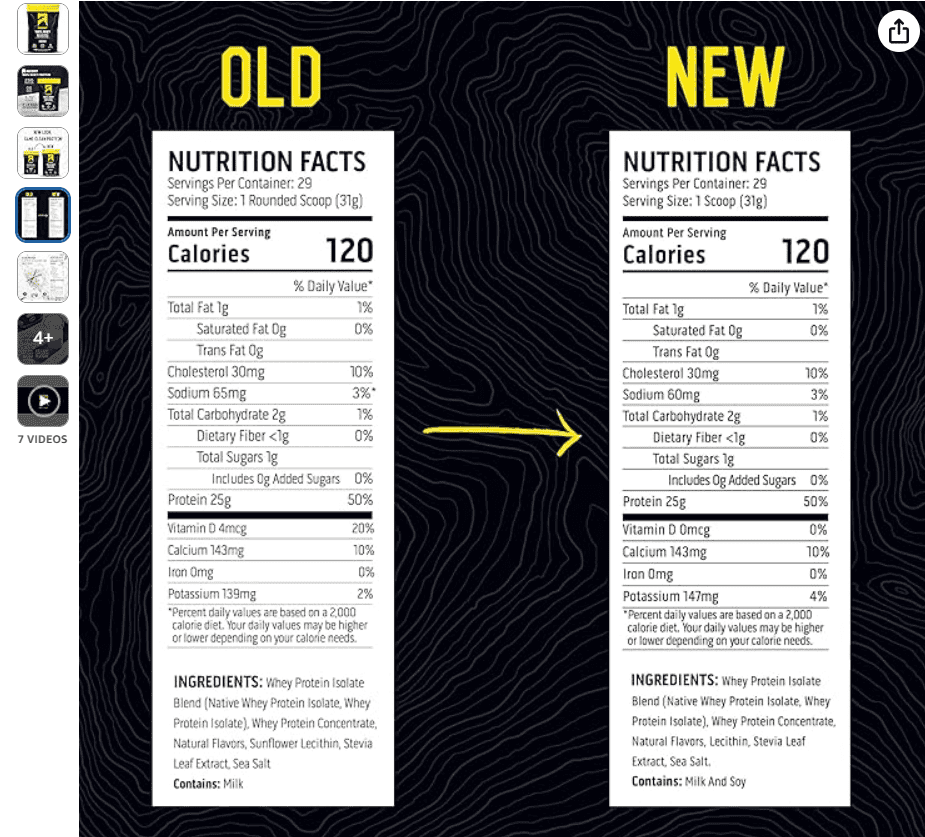
Ascent Native Fuel Whey Protein Powder Vanilla Bean has a minimal ingredient list—no artificial junk, just a three-protein blend.
- Native Whey Protein – Primary source, bringing the leucine.
- Whey Protein Isolate – The main protein driver, delivering high purity.
- Whey Protein Concentrate – Likely included for taste and texture.
- Sunflower Lecithin – Helps with mixability.
- Stevia Leaf Extract – The natural sweetener choice.
- Sea Salt & Natural Flavors – Enhances taste.
In mid-2024, Ascent Native Fuel Whey Protein Powder underwent a formula change, now including soy—but not where you’d expect. It’s not listed in the ingredient list outright; instead, it’s hidden under “Natural Flavors.” If you thought you were getting a 100% milk-based protein—think again. Soy is in Ascent Protein.
If you’re looking for a clean formula, Ascent Native Fuel Whey Protein Powder Vanilla Bean delivers. My only real gripe is that there is no information on the filtration process or a Certificate of Analysis (CoA) to verify the claims. Still, it’s a solid alternative to ON Gold Standard Whey, and its major selling point is its USA-sourced whey.
📋 Ascent Protein Ingredients
Ascent Native Fuel Whey Protein Powder keeps its ingredient list simple, with a blend of three different protein sources:
| Ascent Native Fuel Whey Protein Powder Vanilla Bean | |
| Ingredient | Purpose |
| Native Whey Protein | Primary protein that offers the high leucine content |
| Whey Protein Isolate | Secondary protein source, mainly offering the high protein content |
| Whey Protein Concentrate | Third protein source, main ingredient offering fat, carb, and supplementary protein |
| Natural Flavors | Flavoring and aroma |
| Sunflower Lecithin | Emulsifier |
| Stevia Leaf Extract | Zero-calorie natural sweetener |
| Sea Salt | Flavoring |
At the end of the day, Ascent Native Fuel Whey Protein Powder is a three-protein blend. While native whey provides leucine, the bulk of the protein content comes from isolate, with concentrate likely supporting taste and texture.
One last thing to note about Ascent Protein—its formula changed in mid-2024. The updated version now contains milk and soy. However, soy isn’t explicitly listed in the ingredient list—it’s hidden under “Natural Flavors.”
✅ Is Ascent Protein Clean?
Is Ascent Protein Clean? That depends on what clean means to you. Ascent Native Fuel Whey Protein Powder keeps things simple with just a few ingredients—no artificial flavors, colors, or fillers. It’s also gluten-free, soy-free, and rBST/rBGH-free.
However, if your definition of clean includes cold processing to preserve nutrients and reduce lactose, Ascent Native Fuel Whey Protein Powder doesn’t provide those details. While it emphasizes in-house protein production, it doesn’t disclose the exact filtration method, leaving some questions unanswered.
So, is Ascent Protein clean? It checks the box if you’re looking for a protein powder with minimal ingredients and USA-sourced whey. But if cold processing and transparency in filtration matter to you, there’s still some missing info. That said, Ascent Native Fuel Whey Protein Powder is an alternative to ON Gold Standard Whey (which uses whey from India) for those prioritizing U.S.-sourced ingredients.
🌍 Is Acent Protein Using USA Sourced Whey?
Ascent Protein states on its packaging:
“We don’t buy any of our proteins. We make our own protein—and we’ve been doing it for over 30 years. We buy the milk from trusted dairy farmers and then filter the protein in our own facilities.”
At first glance, this suggests that Ascent Protein sources its milk from U.S. dairy farms, processes it in its whey facility, and then packages the final product. However, looking closer, the brand also claims its protein is gluten-free, soy-free, and rBST/rBGH-free—standard industry claims.
You already know how I am with label claims. As we covered in third-party testing, these are just words without a Certificate of Analysis (CoA). A reminder, Ascent Protein is certified gluten-free. However, one key phrase—“made with international and domestic ingredients”—is missing from Ascent Protein’s packaging and Amazon listing.
So, is Ascent Protein using U.S.-sourced whey? Based on the details provided, I believe so. The usual red flags are absent, and Ascent Protein’s country of origin is listed as the USA on Amazon.
Ingredients List: 8.5 out of 10.
The minimal ingredient list in Ascent Native Fuel Whey Protein Powder Vanilla Bean is a standout feature. There are no artificial additives or unnecessary fillers—just a clean, straightforward formula. My only gripe is that it uses stevia, but that’s a personal preference.
If you’re wondering, is Ascent Protein Clean? The answer is a resounding yes if your definition of clean means zero artificial sweeteners and ingredients. Plus, it’s implied that Ascent Native Fuel Whey Protein Powder Vanilla Bean is made with USA-sourced whey, making it a great alternative to ON Gold Standard Whey sourced from India.
My only real complaint is that I’d like more transparency. Soy is hidden behind the “Natural Flavors” label. I’d also like information on the filtration method and a Certificate of Analysis (CoA) to verify claims.
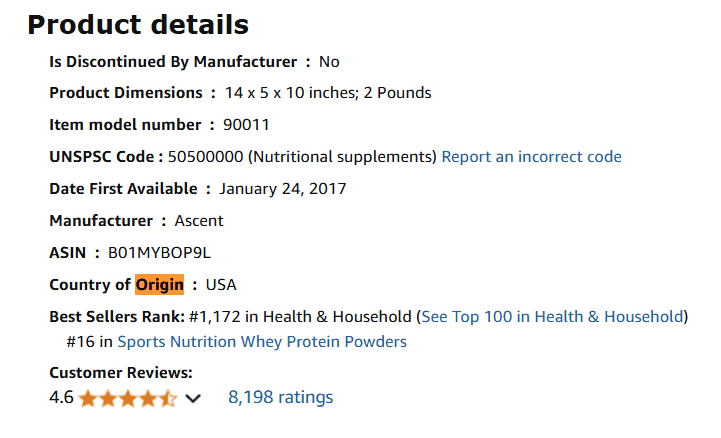
🔑 Ascent Protein Powder Nutrition Facts, TL;DR
Ascent Protein Vanilla keeps things lean at 120 calories per serving, with a solid 81% protein-by-weight. Each 31g scoop delivers:
- 25g Protein – Higher than most blends, with whey isolate as the main source.
- 1g Fat – Low-fat profile, typical for isolate-heavy formulas.
- 2g Carbs – Minimal, with <1g fiber and 1g sugar from natural sources.
- 65mg Sodium – Lower than many competitors.
Unflavored ranks highest for protein percentage, but Ascent Protein Vanilla is still one of the best options for those who want a flavored version without sacrificing much protein content.
🥗 Ascent Protein Powder Nutrition Facts
Ascent 100 Whey Protein Powder keeps things light with 120 calories per serving, making it a lean option for those tracking intake. Each 31g scoop delivers:
| Ascent Protein Powder Vanilla | |
| Nutrients | Amount per Serving |
| Serving Size (g) | 31 |
| Calories | 120 |
| Total Fat (g) | 1 |
| Sodium (mg) | 65 |
| Total Carbohydrates (g) | 2 |
| Dietary Fiber (g) | <1 |
| Total Sugars (g) | 1 |
| Protein (g) | 25 |
If you’re after clean ingredients with solid macros, Ascent 100 Whey Protein Powder meets those criteria. However, the Nutrition Facts don’t reveal filtration details—something I wish they’d clarify. Still, it is a strong alternative to ON Gold Standard, especially for those prioritizing USA-sourced whey with a simple ingredient list.
🍗 Protein Percentage per Serving in Ascent Protein Powder
If you measure value by protein percentage per serving, not all Ascent Protein Flavors are created equal. Across the lineup, Ascent Protein Powder averages 77% protein-by-weight, but some flavors pack more protein per scoop than others.
| Ascent Protein Flavors | Protein per Serving (g) | Scoop Size (g) | Protein Percentage (%) |
| Vanilla Bean | 25 | 31 | 81 |
| Chocolate | 25 | 33 | 76 |
| Chocolate Peanut Butter | 25 | 35 | 71 |
| Mocha Cold Brew | 25 | 33 | 76 |
| Unflavored | 25 | 30 | 83 |
| Average Protein Percent Across All Ascent Protein Flavors: 77% | |||
Unflavored Ascent Protein Powder is the best bet if you prioritize pure protein content. It skips the extras, keeping the highest protein percentage of the bunch. Vanilla Bean follows closely behind for those who prefer a flavored option without sacrificing too much protein.
That said, if you’re wondering, is Ascent Protein Clean? Unflavored is the clear winner. It contains the least additives, reinforcing Ascent’s claim of a minimal ingredient formula with USA-sourced whey.
Nutrition Facts: 7.5 out of 10.
The final score for Ascent Protein Powder Vanilla is based on the average protein percentage across all flavors, landing at 77% protein-by-weight. While Ascent Protein Powder Vanilla offers a solid 81% protein percentage, some flavors dip lower, lowering the overall score. If you prioritize protein content, Unflavored ranks highest, but Ascent Protein Powder Vanilla still holds its own as one of the better options.
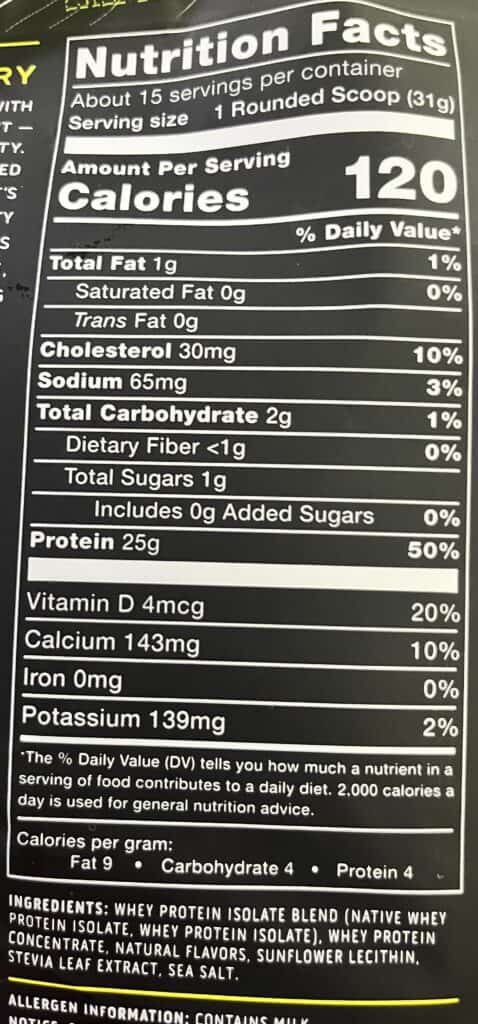
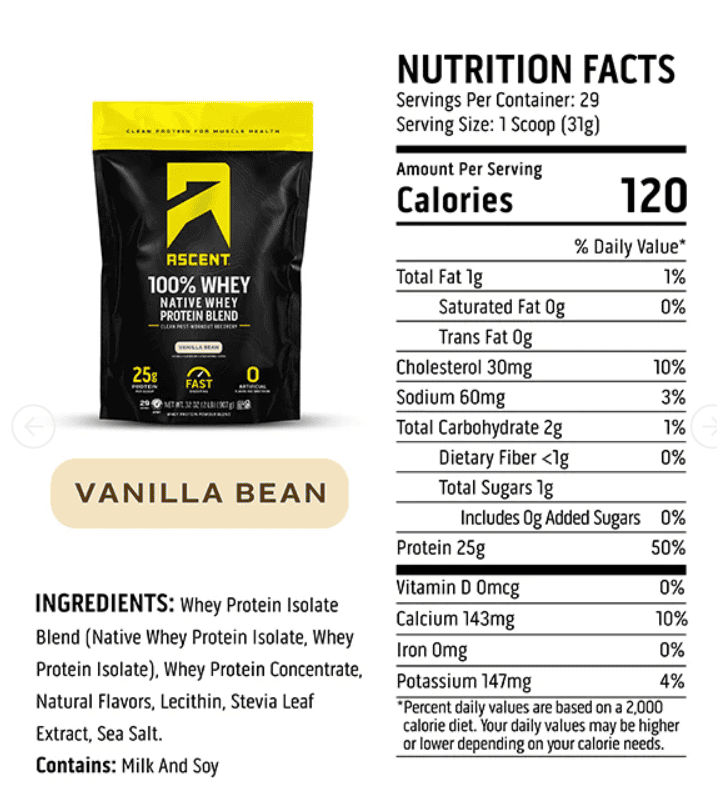
❓ Ascent Protein Powder FAQ
No. Ascent Protein is not NSF Certified for Sport. However, it is Informed Sport Certified, which has been tested for banned substances. If you’re looking for an NSF-certified whey protein, options like Momentous or Thorne might be better.
Yes. Ascent Protein is certified gluten-free and lists no gluten-containing ingredients on the label. If you have celiac disease or gluten sensitivity, this protein should be safe—but as always, cross-contact risk depends on the facility’s cleaning protocols. It is not listed that Ascent Protein is manufactured in a facility with cross-contaminants.
No. Ascent Protein is not organic and does not carry a USDA Organic certification. If you’re after an organic whey protein, options like AGN Roots, Raw Organic Whey, or NorCal Organic Whey would be better.
Ascent does not publicly disclose heavy metal testing results. While Informed Sport Certified screens for banned substances, there is no third-party verification for heavy metals. When I contacted Ascent for a Certificate of Analysis (CoA), they didn’t respond, so there’s no way to verify purity.
Only certain flavors. Mocha Cold Brew contains 100mg of caffeine per serving, roughly the same as a cup of coffee. All other flavors—including Vanilla Bean, Chocolate, and Unflavored—are caffeine-free.
Yes. Ascent Native Fuel Whey contains whey isolate, native whey, and whey concentrate, meaning it still has trace amounts of lactose. If you’re lactose-intolerant, you may want to stick with a 100% whey isolate like Dymatize ISO100 or Legion Whey+ for lower lactose content.
Yes—but it’s hidden. The allergen label now lists milk and soy, even though soy isn’t explicitly listed in the ingredients. The likely culprit? Natural flavors. Soy is often used to boost amino acid content, which makes the “clean” label claim misleading. This isn’t a 100% dairy-based protein if you’re avoiding soy.
Yes, but transparency is lacking. Ascent does not disclose a full amino acid breakdown on the label. Instead, they list BCAAs (5.4g) and leucine (2.6g), which dropped slightly after the mid-2024 reformulation. Without knowing protein blend ratios (native whey, isolate, concentrate), there’s no way to confirm the exact amino acid profile.
Not really. Ascent Protein is designed for post-workout recovery, not as a full meal replacement. It’s low in calories (120 per scoop), carbs (2g), and fats (1g), meaning it won’t keep you full for long. If you’re looking for a meal replacement, check out my reviews on meal replacement protein powders.
Yes. With 2g of carbs per serving, Ascent Protein can fit into a low-carb or keto diet. However, if you’re strict keto and need a zero-carb option, Isopure Zero Carb Whey might be a better choice.
Yes, but it’s not the best option. Each scoop delivers 25g of protein and 2.6g of leucine, which meets the threshold for muscle protein synthesis (MPS). However, the formula contains hidden soy, and Ascent doesn’t disclose the exact ratios of whey isolate, native whey, and concentrate. Optimum Nutrition Gold Standard Whey might be a better choice if transparency matters.
🏁 Ascent Native Fuel Whey Review – Final Thoughts
If you’re considering Ascent Native Fuel Whey, here are three things to know before buying:
- Not 100% Dairy-Based – Ascent markets itself as “clean,” but the latest formula quietly added soy, hiding it under “natural flavors.” If you thought you were getting a pure whey protein, think again.
- Decent Quality, But Not the Best Value – At $1.37 per serving, Ascent is mid-priced. It’s not overpriced, but ON Gold Standard Whey delivers nearly identical macros with better transparency and no hidden soy.
- No Artificial Ingredients – If avoiding artificial additives is a priority, Ascent is a solid pick. However, the lack of full ingredient transparency and the quiet formula change should make buyers think twice before assuming it’s the “cleanest” option.
At a glance, Ascent Native Fuel Whey looks like a value purchase option with a clean label, but the hidden soy and lack of full transparency raise some concerns. While it’s not the worst protein on the market, there are better options if you’re looking for 100% dairy-based protein with verified ingredient sourcing.
So, is Ascent Protein good? Let’s break it down.
✅ Is Ascent Protein Good?
If you’re after a mid-priced whey protein with no artificial ingredients, Ascent Native Fuel Whey looks solid on paper. It delivers 25g of protein per serving, keeps carbs and sugars low, and avoids artificial flavors or dyes—making it an option for buyers prioritizing a “clean” label.
But here’s where it falls short:
- It’s not 100% dairy-based. The formula contains soy, likely hidden under “natural flavors,” which raises concerns about amino acid inflation.
- Protein ratios remain unclear. While Ascent does provide a full amino acid profile, it doesn’t disclose the percentage of each protein type in the blend, meaning we don’t know if it’s mostly isolate, concentrate, native whey, or soy.
- Customer service is non-existent. I’ve reached out multiple times about sourcing and transparency. Still waiting on that email—and I won’t be holding my breath.
It’s a decent purchase for the price—but if you value clear sourcing, full transparency, and reliable support, you’ll have to lower your expectations or look elsewhere.
Final Score: 38/50 – 76% (Above Average).
Are you looking for more protein reviews? Here are all of JKremmer Fitness unbiased protein powder reviews. Are you looking for a protein review that I haven’t done yet? Email me at my ‘Contact Me’ page, and I’ll do my best to get an unbiased review out in 4 weeks.
Ascent Native Fuel Whey Protein Powder Review: Is It Still “Clean”?
Summary
Ascent Native Fuel Whey Protein Powder claims to be a clean, high-quality post-workout shake—but did the quiet 2024 formula change impact its reputation? With 25g of protein per scoop, this whey blend still delivers solid macros. However, soy is now hidden under “natural flavors,” raising transparency concerns. It mixes decently, but clumping can occur. Taste? Stevia dominates, making it hit-or-miss. While Ascent still markets itself as a premium protein, better options exist without hidden ingredients.
Pros
- No artificial ingredients
- 25g protein per serving, ideal for post-workout recovery
Cons
- Soy hidden in formula
- Slightly overpriced for the transparency level
- Customer service is unresponsive
🧐 Ascent Native Fuel Whey Review Round-Up
| Category | Score |
| Value | 4 out of 10 |
| Amino Spiking | 9 out of 10 |
| Mixability | 8 out of 10 |
| Ingredient List | 8.5 out of 10 |
| Nutrition Facts | 7.5 out of 10 |
| Overall Score | 38/50, 76%, Above Average |
📑 Ascent Native Fuel Whey Review Sources
Certified Supplements | Certified by Informed Sport. (n.d.). https://sport.wetestyoutrust.com/certified-brands
Garcia-Vicencio, S., Ratel, S., Gryson, C., Masgrau, A., Piponnier, E., Brasy, J., Ruyet, P. L., Bucas, M., Barachon, N., Visseaux, V., Connan, Y., Montel, F., Lahaye, C., Boirie, Y., & Martin, V. (2018). A moderate supplementation of native whey protein promotes better muscle training and recovery adaptations than standard whey protein – a 12-Week Electrical Stimulation and plyometrics training study. Frontiers in Physiology, 9. https://doi.org/10.3389/fphys.2018.01312
Hamarsland, H., Aas, S., Nordengen, A., Holte, K., Garthe, I., Paulsen, G., Cotter, M., Børsheim, E., Benestad, H., & Raastad, T. (2018). Native whey induces similar post exercise muscle anabolic responses as regular whey, despite greater leucinemia, in elderly individuals. The Journal of Nutrition Health & Aging, 23(1), 42–50. https://doi.org/10.1007/s12603-018-1105-6
Kim, J., Jeong, E. W., Baek, Y., Go, G., & Lee, H. G. (2023). Comparison of the effects of commercial whey protein and native whey protein on muscle strength and muscle protein synthesis in rats. Food Science and Biotechnology, 32(3), 381–388. https://doi.org/10.1007/s10068-023-01248-7
Kremmer, J. (2025, January 23). ascent native whey protein review: Not Top of the Podium (2025). JKremmer Fitness.
https://jkremmerfitness.com/ascent-protein-powder-review/#Amino_Acid_Profile_Comparisons
Panchal, B., Truong, T., Prakash, S., Bansal, N., & Bhandari, B. (2021). Influence of emulsifiers and dairy ingredients on manufacturing, microstructure, and physical properties of butter. Foods, 10(5), 1140. https://doi.org/10.3390/foods10051140
Roots, A. (2019, October 26). Grass-Fed whey contains more BCAAs. Sourced the Right WheyTM. https://agnroots.com/blogs/articles-info/highest-bcaa-concentrations
Stark, M., Lukaszuk, J., Prawitz, A., & Salacinski, A. (2012). Protein timing and its effects on muscular hypertrophy and strength in individuals engaged in weight-training. Journal of the International Society of Sports Nutrition, 9(1). https://doi.org/10.1186/1550-2783-9-54
USDA National Nutrient Database for Standard Reference Legacy. (2018). Nutrient content in household measure. https://www.nal.usda.gov/sites/default/files/page-files/leucine.pdf
Ascent Protein. (n.d.). Whey amino acid profile. Ascent Protein Support. Retrieved February 28, 2025, from https://ascent-protein-support-copy.gorgias.help/en-US/whey-amino-acid-profile-573596
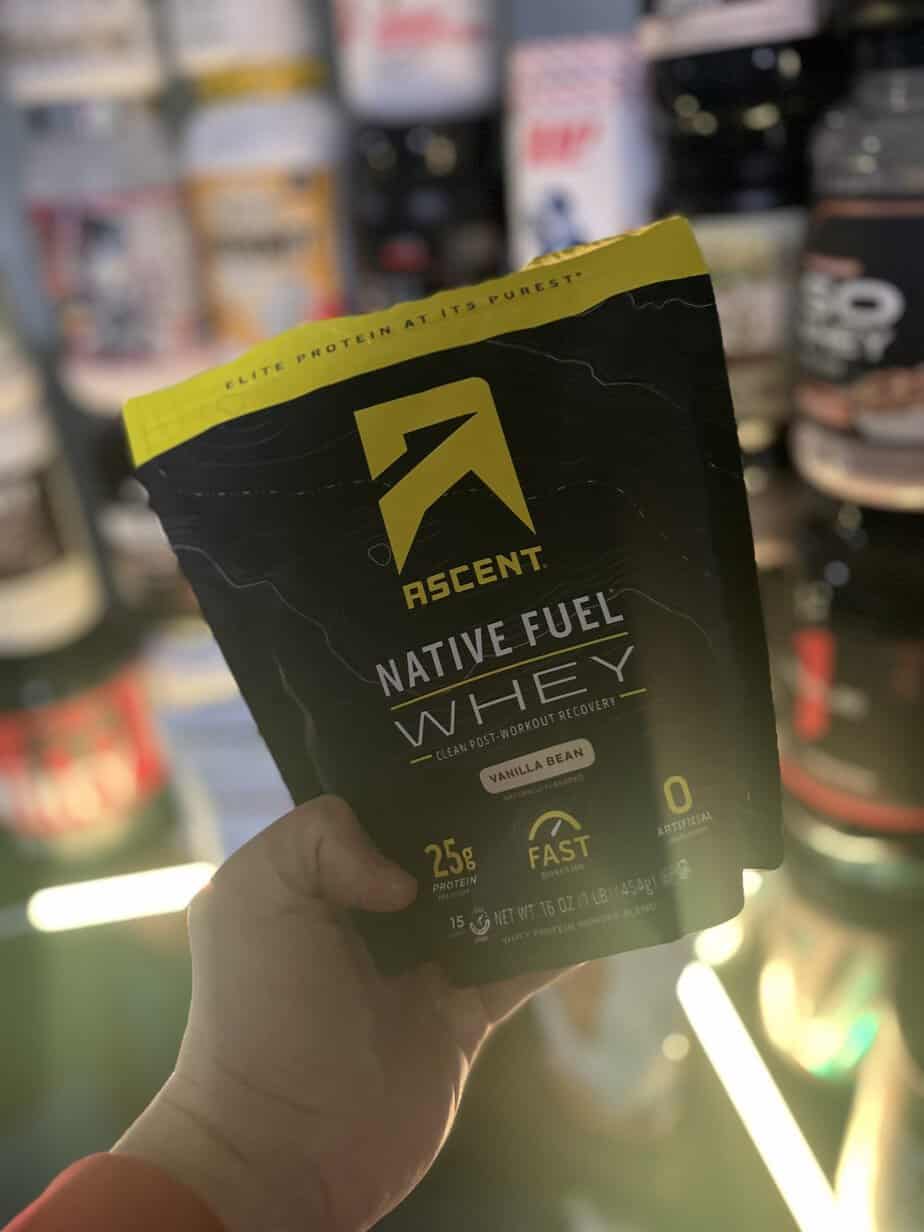

Leave a Reply